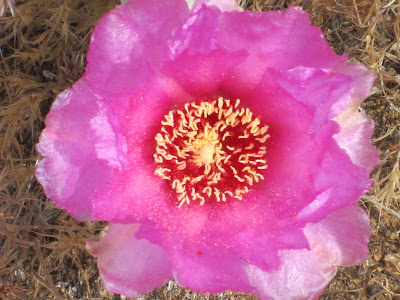The beavertail cactus is a small prickly pear cactus found mostly in the Mojave and Colorado Deserts of the U.S. and in northwest Mexico. They have gray-green stems that are wide and flat resembling the tail of a beaver. They are spineless, but have small bristles, called glochids, that penetrate the skin.
 During times of drought, large animals such as bighorn sheep will eat the beavertails as a source of moisture. The two pictures below, both from the San Felipe Hills, have bite marks in them from bighorn sheep, deer, or some other large animal.
During times of drought, large animals such as bighorn sheep will eat the beavertails as a source of moisture. The two pictures below, both from the San Felipe Hills, have bite marks in them from bighorn sheep, deer, or some other large animal.
 The beavertails have brilliant pinkish-violet flowers from March to June. The one below was found in Mission Creek Canyon.
The beavertails have brilliant pinkish-violet flowers from March to June. The one below was found in Mission Creek Canyon. The next two beavertails were found in Borrego Palm Canyon in Anza-Borrego Desert State Park.
The next two beavertails were found in Borrego Palm Canyon in Anza-Borrego Desert State Park.
 The next two, from the San Felipe Hills, show examples of the flowers in various stages of blooming.
The next two, from the San Felipe Hills, show examples of the flowers in various stages of blooming.
 The beavertails are not as tolerant of the cold as other prickly pear cactus and are found at lower elevations. I noticed that on a backpacking trip from Heart Bar down to Whitewater, along the PCT, where the higher elevation cactus were the prickly pears, followed by the beavertail at lower elevations. Finally, two more beavertails from the San Felipe Hills.
The beavertails are not as tolerant of the cold as other prickly pear cactus and are found at lower elevations. I noticed that on a backpacking trip from Heart Bar down to Whitewater, along the PCT, where the higher elevation cactus were the prickly pears, followed by the beavertail at lower elevations. Finally, two more beavertails from the San Felipe Hills.


Such a beautiful cactus! I LOVE that last picture of that bloom, stunning!
ReplyDeleteTHEY ALSO CAN GROW IN CENTRAL CALIFORINA
ReplyDeleteI HAVE ONE BLOOMING RIGHT NOW IN MY BACKYARD